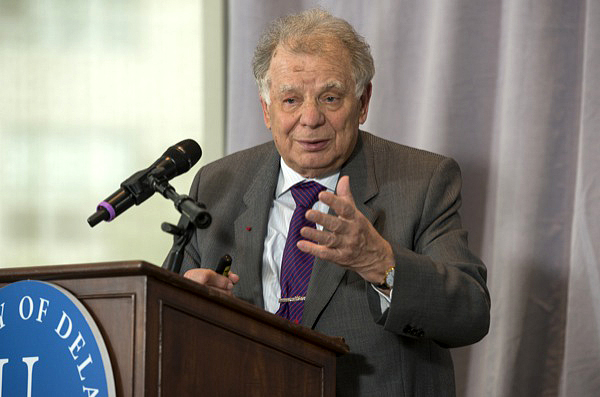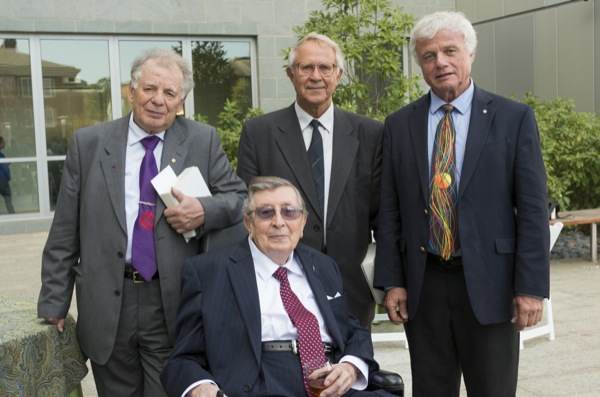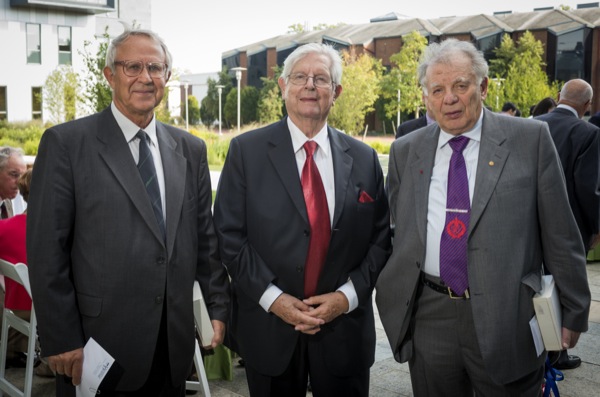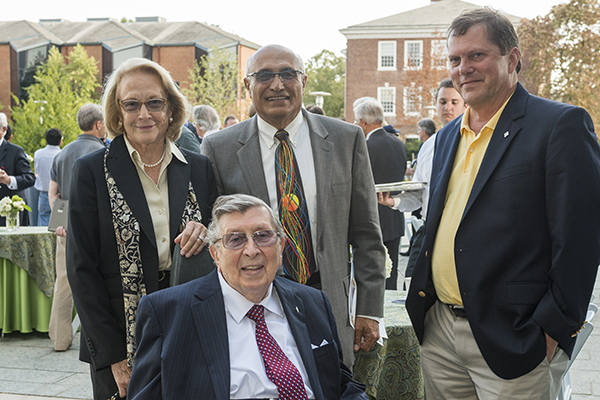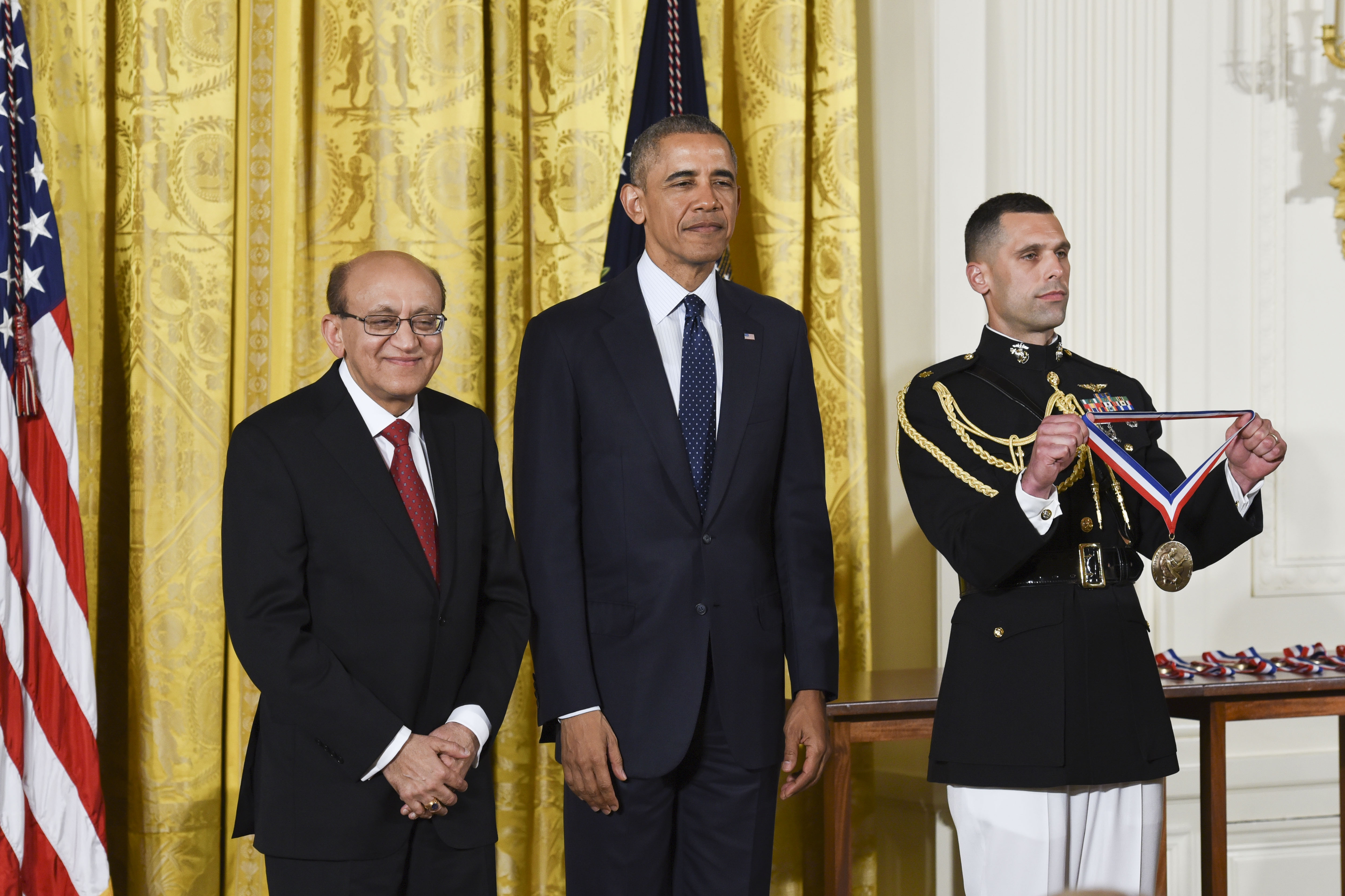

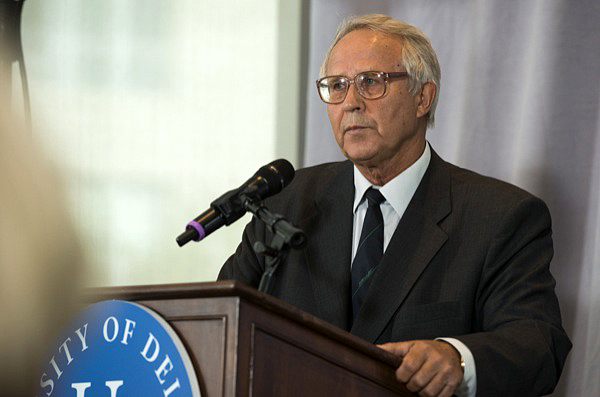
Solar pioneers
Böer Medal winners Alferov, Andreev honored in ceremony at UD
11:28 a.m., Sept. 26, 2013--Zhores I. Alferov, Nobel laureate, professor and president of the St. Petersburg Academic University of the Russian Academy of Sciences, and Viacheslav M. Andreev, professor and head of the A.F. Ioffe Physico-Technical Institute in St. Petersburg, Russia, were awarded the 2013 Karl Böer Solar Energy Medal of Merit during a ceremony held Friday, Sept 20, in the University of Delaware’s Interdisciplinary Science and Engineering Laboratory.
The award is given in honor of Karl Wolfgang Böer, a longtime University faculty member, founder of UD’s Institute of Energy Conversion and a distinguished scientist in the field of solar cells.
Honors Stories
National Medal of Science
Warren Award
George C. Hadjipanayis, Richard B. Murray Professor of Physics and Astronomy, welcomed members of the Böer family, members of the campus community, and many internationally recognized leaders in solar energy research and public policy to the ceremony.
University President Patrick Harker joined Karl Böer in presenting the awards, noting that the occasion marked the 20th anniversary of the first award ceremony.
“Former U.S. President Jimmy Carter was the first recipient of this medal back in 1993,” Harker said. “He was honored for helping to open the world’s eyes to the power and promise of turning abundant sunlight into safe, clean, reliable energy.”
In the succeeding decades, the Böer Medal has recognized nine more significant contributors to the field including researchers and scientists, leaders and advocates and pioneers who pushed the boundaries of solar science, Harker said.
“To see the fruits of their efforts, just consider how often we now see solar panels in common use atop homes, businesses, churches, factories and nearly everywhere we go,” Harker said. “Indeed, solar installations on this campus generate more than 1 million kilowatt-hours of electricity every year.”
David Renné, president of the International Solar Energy Society, lauded the 2013 Böer Medal recipients while giving a brief overview of the organization.
“The mission of the society has been for the longest time to see the world transition to a rapidly renewable energy world, with the ultimate goal of a 100 percent renewable energy world,” Renné said. “This is energy that is accessible to all, including some 1.6 billion people who currently have no access to any reliable energy services, and more than over 2 billion people around the world who are still committed heavily to using unsustainable biomass for their cooking and heating.”
Contributions of Alferov and Andreev
Klaus Thiessen, photovoltaics consultant with WISTA-Management GMBH, noted that the occasion marked the second visit to UD by Alferov, coming 45 years after he attended the International Conference on Luminescence held in Newark. That event had been organized by the late Dr. Ferd Williams, then chair of the physics department, who had invited Böer to join the UD faculty in 1962.
“Earlier, Karl Wolfgang Böer, accompanied by myself, visited the Ioffe-Institute in Leningrad in 1960, where he gave an impressive lecture at the seminar of the famous Evgeni Gross, who discovered the excitons in semiconductors,” Thiessen said. “The elder scientists at Ioffe remember Böer’s work on the high field domains in cadmium sulphide, presently named Böer Domains.”
Thiessen noted that Alferov and Böer were both honored in 2012 with honorary doctorates at the distinguished Technical University in Berlin.
Citing a 2007 report by Alferov and Andreev, Thiessen gave a short overview on their contributions in photovoltaics research and development.
“The first practical application of improved GaAs solar arrays, developed by the Alferov-Andreev team, supplied electric energy for the Russian space probes Venera-2 and Venera-3, which operated in the vicinity of Venus in 1965, as well as for the moon-cars Lunokhod 1 (1970) and Lunokhod-2 (1972),” Thiessen said. “The further progress of the III-V semiconductor solar cells was associated with the development of the semiconductor heterostructures, which have now become a significant part in the manufacturing of cells for both space and terrestrial applications.”
The contributions of solar cell pioneers Alfervov, Andrev and Böer continue to resonate today, Thiessen said.
“Beginning in 2002, there have been nine international conferences devoted solely to concentrator photovoltaic systems, the last one held this spring in Miyazawa, Japan, where Andreev and his group gave several presentations,” Thiessen said. “I am very glad that today, the 11th Karl Wolfgang Böer Solar Energy Medal of Merit has been awarded for the first time in the field of III-V heterojunction concentrator photovoltaics to a team of eminent researchers, Zhores Alferov and Viacheslav Andreev.”
Awardee lectures
During the first of the award lectures, “Will the Future Markets Have Either Silicon or III-V Heterostructures or Both Together,” Alferov outlined the history of solar energy research and his views on the growing role solar energy will play in meeting the world’s energy needs.
“Fossil fuels and thermonuclear power will be finished at some point, but solar power will last for billions of years,” Alferov said. “I’m absolutely sure that by the end of this century, solar energy will be the main source for the solution of all energy problems on our planet.”
In his lecture, “Concentrator Photovoltaics: Status and Perspectives,” Andreev discussed activity in that field, which started 45 years ago and continues with the discovery of new ways for improving the efficiency of multi-junction solar cells.
“Concentrator photovoltaics became a really important branch of photovoltaic science,” Andreev said, with “many installations now installed throughout the Western world.”
There are many ways for improving the applications of the multi-junction solar cells, and also many advantages of developed concentrator photovoltaic installations compared to silicon and thin film arrays, Andreev said.
“There is a decrease in the amount of consumable materials and amount of land needed for the installation of concentrated photovoltaic (CPV) systems,” Andreev said. “The best place for systems are the places with the highest sunshine, especially in southwest North America and the Mediterranean Sea area, and places in the south of Russia.
Böer Medal recipients
Other recipients of the Böer Medal include:
- ¥ 1995, David E. Carlson, chief scientist, BP Solar;
- ¥ 1997, Adolf Goetzberger, founder of the Fraunhofer Institute for Solar Energy Systems;
- ¥ 1999, Stanford R. Ovshinsky, a pioneer in the science of amorphous semiconductors resulting in the development of low-cost, thin film silicon solar cells;
- ¥ 2001, Allen M. Barnett, a pioneer in high-performance, thin-crystalline silicon solar cells as a professor at UD, and now professor of advanced photovoltaics in the School of Photovoltaics and Renewable Energy at the University of New South Wales in Australia;
- ¥ 2003, Martin A. Green, Inaugural Scientia Professor at the Centre for Photovoltaic Engineering in Sydney, Australia, and foundation director for the Centre for Third Generation University of New South Wales in Sydney;
- ¥ 2005, Yoshihiro Hamakawa, adviser professor to the chancellor at Ritsumeikan University in Shiga, Japan and a prominent scholar in the field of solar photovoltaic energy;
- ¥ 2007, Lawrence L. Kazmerski, executive director, Science and Technology Partnerships, National Renewable Energy Laboratory and a pioneer and leader in the field of solar electricity;
- ¥ 2009, Hermann Scheer, a member of German Parliament, president of EUROSOLAR and chairperson of the World Council for Renewable Energy, who has made an outstanding contribution to the worldwide understanding of the necessity to replace fossil and nuclear resources by renewable energies, especially solar energy; and
- ¥ 2011, Richard M. Swanson, president and chief technical officer at SunPower Corp., San Jose, Calif., for the invention of the point contact solar cell, and further innovations that make solar energy ever more efficient and cost effective.
Article by Jerry Rhodes
Photos by Kathy F. Atkinson




